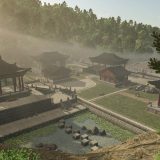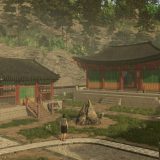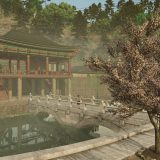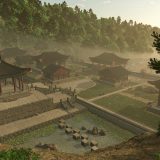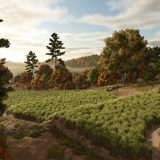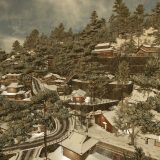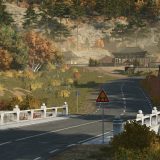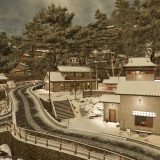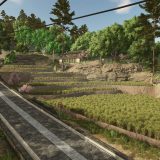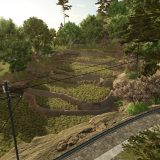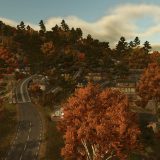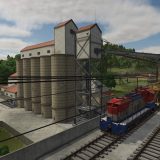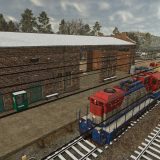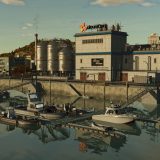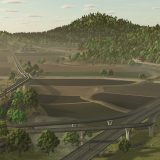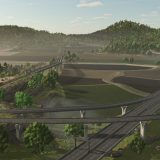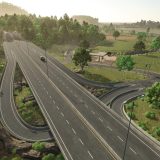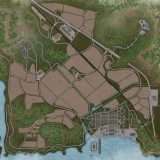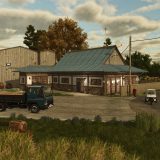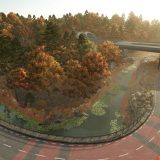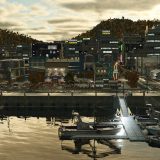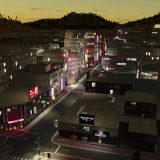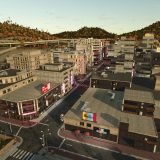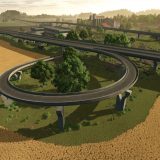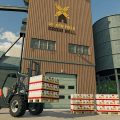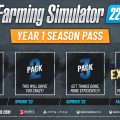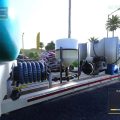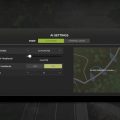Welcome to Hutan Pantai, where the harmony of the East Asian countryside meets the vibrancy of modern cities – a symbiotic relationship, as Associate Producer and Technical Artist Horia Serban calls it. Learn more in our interview as he explains what he and his team of environmental artists envisioned when creating the map.
Farming Simulator 25 releases November 12th. There’s still some time to pre-order which gets you the MacDon Pack! Or go for the fancy Collector’s Edition, including a USB Ignition Lock to start your in-game tractors.
Horia, tell us a bit about you and your position!
I’m an Associate Producer for the Environment Department here at GIANTS Software, and I also work as a Technical Artist. I’ve been in the gaming industry for about 20 years now, and for the past 8, I’ve had the pleasure of working at GIANTS. My journey here started with Farming Simulator 17 back in 2016, and I immediately connected with the unique aspects of the game. Before joining, I worked on a variety of titles, like Call of Duty: Ghosts, Dead Rising 3, and Test Drive Unlimited 2, mostly in outsourcing.
But it was with Farming Simulator that I found a new passion – this game is special to me, and being part of its growth and evolution has been truly exciting. Watching the franchise expand over the years and knowing I’ve played a role in that journey brings me so much happiness and pride. I’m thrilled to help bring this world to life for our players, season after season.
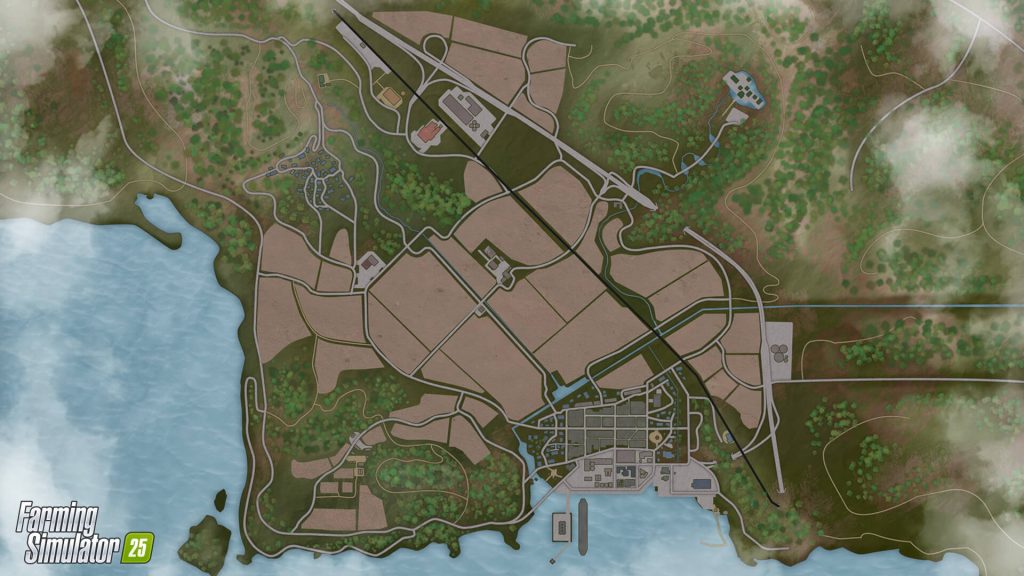
Inspiration & Atmosphere
What kind of atmosphere were you aiming for?
With the Hutan Pantai map, we wanted to create an authentic East Asian atmosphere that embodies the harmony between countryside landscapes and the vibrant, modern cities typical of this region. This symbiotic relationship—where the bustling cities are sustained by the hard work and dedication of the rural areas—is central to the map’s vision. The contrast and connection between these two areas were essential elements for us to capture.
We also wanted to integrate specific elements unique to the region, showcasing how the modernization of cities has facilitated the movement of goods. Through features like elevated highways and suspended train bridges, we connect the fields to the urban centers, creating a seamless flow that mirrors real-world infrastructure. Our goal was to present a world that feels both familiar and rich with the unique cultural blend of East Asia.
In addition, we made it a priority to preserve the heritage and culture of the region by designing a traditional village and a temple area, both with architectural styles that have been in use for hundreds of years. These elements honor the historical and cultural richness of the area, ensuring authenticity and a sense of legacy.
Where did the inspiration come from?
Our inspiration came from a variety of sources, each helping to shape a different aspect of the Hutan Pantai map. For the traditional village area, we drew heavily from Studio Ghibli films, especially ‘From Up on Poppy Hill’, one of my favorite animated films. Ghibli’s art captures the soul of these small, timeless villages, and that’s the feel we wanted for this area.
For the industrialized town area, we looked to the vibrant, neon-lit streets of bustling cities like Seoul and Tokyo. Those lively, illuminated scenes bring an energy that reflects the rapid pace of modern life, something we aimed to recreate with our urban spaces through bright lights and dynamic structures.
The inspiration for the temple area came from multiple sources, including several K-dramas and close-up visual references that beautifully showcase the intricate architecture of these structures. By drawing from these detailed depictions, we were able to create a space that feels authentic and respectful of the cultural heritage it represents.
For the farming areas, we explored both traditional and modern agricultural practices unique to East Asia. We wanted a blend that showcased the roots of farming life alongside its evolving practices, creating an experience that honors the past while embracing the future. Drawing from such a wide variety of sources allowed us to bring a diverse and immersive world to life, filled with elements that feel true to the essence of East Asia.
Creation & Challenges
When starting to work on a new map – how do you approach it?
Every new map starts with extensive research focused on the specific area or theme we’re aiming to recreate. We dive deep into the culture and unique characteristics of that region to bring the most authentic experience to our players. Our approach involves splitting up tasks within the environment department to ensure we gather as much relevant information as possible.
Some of our team members focus on researching the local architecture, while others concentrate on understanding the vegetation, farming practices, and community-specific elements we need to capture. We also pay close attention to details that we should avoid to ensure the map is respectful and enjoyable for our community.
Once the research phase is complete, we move into the prototyping or pre-production stage. Here, we experiment by gray-boxing, creating basic 3D models to establish the layout of the map. This stage allows us to test and adjust the positioning of essential elements like production buildings and landmarks. It’s an exciting process of turning research into a tangible environment, and it helps us set a strong foundation for the final map.
How did you approach the environmental design and landscape?
Our approach to Hutan Pantai’s environmental design started with a clear vision focused on symmetry and balance. This map stands apart from others by emphasizing the unique contrast between tradition and modernization, a recurring theme in the region’s landscapes. We concentrated the industrial area near the city, where a port serves as the endpoint for the farming process, symbolizing the export of goods beyond the map’s boundaries. While this is just a metaphor rather than a gameplay feature, it reinforces the flow and purpose of the farming life cycle.
Our goal was to capture the essence of East Asia as accurately as possible, blending the charm of the countryside with the dynamism of industrial progress. The flow of farming processes on this map moves from the southwest to the northeast, guiding players through this journey of production and transportation. It’s all about balance—maintaining an equilibrium between heritage and technology, old and new. This balance is not only in the physical layout but also in the map’s character, creating an experience that feels true to the cultural and geographical realities of East Asia.
What were some of the challenges in the creation of the map?
Creating the Hutan Pantai map brought its own set of challenges, especially with the complexity of the city. This was beyond anything we’d done before, so we had to carefully balance authenticity with performance. We wanted the city to feel real and dynamic without taking up too much of the map’s surface area or impacting performance on consoles and PCs. Achieving that balance was a significant technical and creative challenge.
Another major challenge was designing the infrastructure to connect the city with the rural areas. Building a highway that seamlessly links the main city to the rest of the map required meticulous planning, and adding tunnels to the route brought another layer of complexity. Ensuring this infrastructure was both functional and visually integrated into the landscape was a true test of our design and engineering skills.
Team Efforts
What aspects are you the most proud of/what’s your favorite part of the map?
I’m proud of every part of this map and what we achieved with Hutan Pantai, pushing the boundaries a bit further. But what I’m most proud of is the incredible work of our Environment Team. Their talent and dedication truly brought this vision to life.
Our technical artist, Evgen, played a huge role in the technical breakthroughs we needed. Kevin, who has an amazing eye for detail, meticulously refined every element with a patience and precision that brought out the best in each piece of the map. Our vegetation team, Vanessa and Kenan, created the rich, immersive plant life that adds so much depth. Gabriel poured countless hours into bringing the neon-lit cityscape to life, making it pulse with energy. And Anton, who had the patience and dedication to elevate every element, always pushed to make everything just a bit better.
It’s a team effort through and through, and seeing each of their contributions come together in this map is what I’m most proud of.
Hutan Pantai Preview



